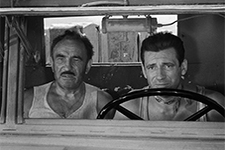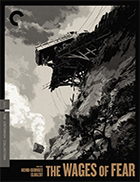The Wages of Fear (La Salaire de la peur) (4K UHD)
|  Henri-Georges Clouzot’s existential suspense classic The Wages of Fear (La Salaire de la peur) opens in Las Piedres, a village in a poor, unnamed country somewhere in South America. It is a lost, dilapidated place of nearly suffocating heat where naked children play in the street and men sit around listlessly, waiting for some kind of escape. It is a place where desperate people come to escape their various pasts, and we get the sense that, having found escape, they now have no place to go. The opening passages of The Wages of Fear are lengthy and slowly placed, as Clouzot uses them to establish his main characters, as well as a sense of time grinding along at a pace that would make most people lose their mind. The film has been criticized for the slowness of these opening scenes, which take up nearly an hour of the running time, but they are crucial in showing why the characters do what they do and are willing to take extraordinary risks—to, in essence, establish a price for their own lives. The two main characters are Mario (Yves Montand), who has been in the village for a long time, and Jo (Charles Vanel, winner of the Best Actor award at Cannes), who arrives in a fancy suit with just enough money to bribe his way past the authorities at the tiny airport and not much else. Along with two other men, they accept a job from an American oil company to drive two trucks loaded with nitroglycerin 300 miles along rough mountain roads. It is extremely dangerous work, as the slightest bump is enough to set off the explosives, and the fact that they are willing to take it on speaks to their sense of desperation. There is, simply put, no other way out (and the fact that so many men apply for the job speaks to just how many desperate men are hiding in this village). The Wages of Fear was originally censored when it was first released in the United States in 1955, two years after it won the Grand Prix at the 1953 Cannes Film Festival (it wasn’t until 1991 that the fully restored French theatrical version was released in the U.S., first in a limited theatrical run and then on laserdisc by The Criterion Collection). Much of the snipped footage had to do with the American Oil Company, which is here named the Southern Oil Company, but whose initials S.O.C. visually suggest the American giant Standard Oil. The men who run the company are depicted as having no compunction about using people to their own ends. They hire drivers from the village for the nitroglycerin run because they are not in a union and they have no family, thus there is no one to complain and sue if they should die. Clouzot’s film is clearly meant as an indictment of American big-business practices, where profit is put ahead of everything else. Sometimes, this leads Clouzot to some imagery that is a little too on the nose, such as an S.O.C. Jeep careening down a village street, splashing mud in the faces of its oppressed inhabitants. Yet, the film is not so simple, as the men who accept the job are far from heroic. In fact, even though we know little about them, it is clear that they are not “good men” in any sense of the word. In the early scenes, we witness Mario emotionally and physically abusing a local barmaid named Linda (Véra Clouzot), who is desperately in love with him. Jo is not much better, as he puts on a big show, but is really an underhanded and cowardly scoundrel who is willing to exploit anyone and any situation to his benefit and runs when there is danger. But, even in this sense, the film is not so black and white, as the long drive through the back jungles and mountains of South America reveal different aspects of the characters. Mario develops into a genuine leader, one who does not hide his fear, but rather controls it. On the other hand, Jo exposes himself as a coward, someone who talks a good talk, but ultimately fails to back it up with his actions. His hardened exterior melts away with the growing tension, revealing a frail, weak old man who is so afraid to die that he is willing to return to his aimless life in the village without completing the mission. The mission itself is the heart of The Wages of Fear, and the suspense Clouzot generates along the way is justifiably famous. The film’s production was notoriously difficult and drawn out by inclement weather, sickness, and accidents that pushed it way over budget. Compared to the computer-generated mayhem of modern action blockbusters and superhero films, The Wages of Fear might seem almost antiquated, but there is no denying that Clouzot perfectly intertwines narrative tension with character development. There are three major suspense sequences during the long trip: one in which the characters have to back their trucks along an unfinished, feeble wooden bridge that is constantly threatening to collapse, one in which they must use the nitro to blow up a large boulder that has fallen in the road, and one in which Mario and Jo must cross an ever-deepening pool of crude oil from a burst pipeline. Each sequence is expertly shot and edited, drawing the maximum amount of tension from the situation while also revealing more and more layers of the characters. In this sense, The Wages of Fear is a genuine masterpiece, one that makes so many of today’s mindless action extravaganzas look all the more shallow.
Copyright © 2025 James Kendrick Thoughts? E-mail James Kendrick All images copyright © The Criterion Collection | |||||||||||||||||||||||||||||
Overall Rating: 


 (3.5)
(3.5)


